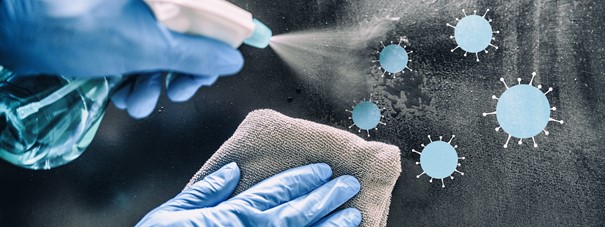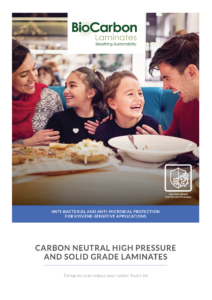

Antimicrobial Protection for Sheet Materials
At the height of the pandemic during the lockdown period, materials to combat the spread of infection were in short supply and sales of Anti-Bacterial wipes, handwash, and hand sanitiser gel were restricted. Probably for the first time, we started to question the active ingredients of these products and to reflect on their efficacy.
Within the built environment, these questions are far from new to interior designers and architects involved in making specifications for environments where minimising the transmission of infection is a priority, especially in healthcare settings, commercial kitchens, sports facilities, and transport hubs.
Germ Warfare
And now, to help combat COVID-19, employers are already making significant changes to existing workplaces with new room layouts, the installation of Perspex® partitions and screens, floor marking signage to promote social distancing, and widespread access to hand-sanitising stations.
Future developments could see the introduction of thermal body scanning equipment to help detect individuals with a raised temperature, and the introduction of contactless security measures such as facial recognition at entry points, and touchless technology that enables doors and lifts to be activated automatically. Future-proofed buildings are likely to see the installation of air conditioning that uses UV light to kill pathogens. Employers may introduce biophilia which makes use of natural planting as an alternative to plastic screens to separation.
In addition to the possibility of the airborne pathogens that we are all now trying to mitigate with the use of face coverings in crowded settings, everyone understands that infection can also spread through personal contact, and behaviours have changed with social distancing essential to minimise the critical reproduction rate for COVID-19 or ‘R’ number. Contact extends to touching surfaces such as door handles, light switches, tables and work surfaces where germs may remain sometimes for as long as several months.
As the risks associated with touch become more high profile, architects and designers of commercial interiors are increasingly examining the properties of decorative sheet materials and assessing their contribution to reducing the spread of infection.

Anti-Bacterial vs Anti-Microbial Protection
As concern about the spread of COVID-19 sees a resurgence in the UK following the easing of lockdown, materials that prevent the spread of infection are likely to remain under scrutiny well into the future. It is worth reviewing the relative claims and properties of these materials and how they can be integrated within future design solutions.
Dissecting the meaning behind the terminology reveals key differences between the microorganisms that Anti-Bacterial and Anti-Microbial materials protect against, as follows:
- Anti-Bacterial: provides specific protection against the spread of infections caused by bacteria such as E. coli, and Salmonella.
- Anti-Microbial: will kill 99.9% of bacteria and slows the spread of microorganisms. Microorganisms include bacteria, viruses, protozoans and fungi such as mould and mildew.
Materials with the properties of anti-microbial resistance use nanotechnology to embody active ingredients such silver ions that are inorganic and non-toxic.
One of the most pertinent applications of Anti-Microbial technology is on surfaces made from high pressure and solid grade laminate used to create table tops, counters, worktops, shelving, and cupboards, or in washroom and reception areas in settings such as:
- Hospitals and surgeries
- Medical analysis centres
- Nursing homes
- Mental health facilities
- Veterinary practices.
As well as in food contact settings such as:
- Hotels
- Restaurants
- Cafes
- Catering facilities
- Domestic kitchens.

Benevolent Benefits
In addition to their germ-inhibiting properties, the silver ions in Anti-Microbial surfaces are non-soluble and highly resistant to moisture that can cause mould to form, and so they contribute to the durability, appearance, quality, and longevity of commercial interiors. All this can be achieved with no loss of aesthetic appeal and no adverse impact on design.
As well as making sense from a value for money perspective, the installation of Anti-Microbial surfaces as part of a human-centred design concept delivers multiple additional benefits. A cleaner environment promotes employee wellbeing, better health, and increased productivity, potentially reducing the number of days lost to sickness absence.
Ways to reduce the spread of infection of all types is more imperative than ever before and the installation of Anti-Microbial surfaces could make a significant contribution to industry’s ability to develop healthier future workplaces. This provides a boost to corporate social responsibility and you can help to improve the reputation of your practice or client by achieving standards such as those set out by the WELL organisation which provides accreditation for prioritising health and wellbeing in buildings.
Taking care of the human inhabitants of the buildings we design goes hand in hand with a commitment to the environment and choosing decorative sheet material that is also Carbon Neutral further increases its appeal.
It is worth researching the options available, some of which are now capable of addressing a myriad of goals and objectives in one clean sweep.
To download our Anti-Bacterial and Anti-Microbial brochure click here

About BioCarbon Laminates
BioCarbon Laminates, one of the latest products to reach the commercial interiors market, was launched at Futurebuild 2020. Produced in a carbon neutral manufacturing facility, BioCarbon Laminates engage in carbon off-setting by using renewables including hydroelectric energy, a programme of exchanging VOC emitting resins for water-based alternatives and investing in global wind farm projects and countering CO2 emissions with a reforestation programme. Its decorative laminates deliver all the benefits of its competitors including quality, durability, resistance to stains and Anti-microbial properties, at no additional cost.